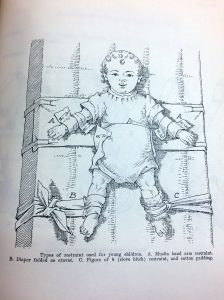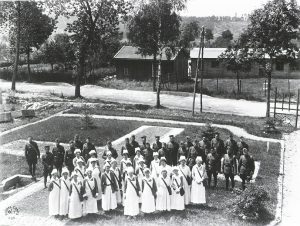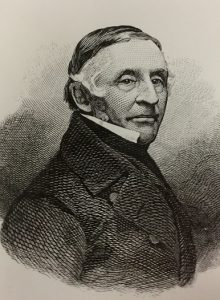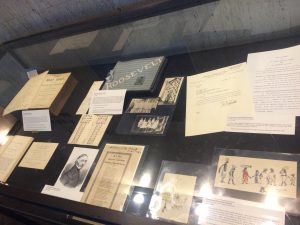Jun 8, 2017
The Arthur H. Aufses, Jr. MD Archives recently received a copy of the 1957 Mount Sinai Nursing Department Manual of Nursing Procedures from Gail Singer Lyon, member of the Class of 1962 of The Mount Sinai Hospital School of Nursing. Manuals like these have value because they show what the patient experience and medical care were like then, and they provide a sense of what the duties of a nurse were at a given point of time. The Archives has many such manuals from 1931 up to the present day, and they provide great information on how nursing, medicine, and hospitals have changed over this span.
While the Archives has other copies of this edition of the Manual, what makes this copy special are the extras that Ms. Lyon has included with her volume, from inserts to doodles. The manuals were given to the students to govern their practice when they were in the clinical areas of the Hospital. It includes detailed instructions on everything from Abdominal Binders to Wall Suction, Method of Using. Throughout the Manual, when it is necessary to provide examples using the names of doctors, the procedures referred to them as Dr. Roe and Dr. Moe. The patient is, of course, John or Jane Doe. Ms. Lyon wrote hints and additional information on the pages of her volume, and also inserted forms and updates to the policies.
This post highlights some of those ‘extras’ that make this volume interesting.

This form shows the communications technology of the time. Note the bottom row for how a family would be reached in time of emergency.

A lovely drawing showing how to restrain a child

A doodle, clearly showing a woman wearing a Mount Sinai Hospital School of Nursing cap, with is many pleats in the front.
Apr 17, 2017

Nurses and doctors of St. Luke’s Hospital Evacuation Hospital No. 2
April 2017 is the 100th anniversary of the entry of the United States into World War I. Like many institutions in American society, the American hospital system and its doctors and nurses were rapidly mobilized to join the war that had been raging in Europe since the summer of 1914. The Mount Sinai Archives has now installed a display in the Annenberg Building north lobby outlining the activities of the hospitals in the Mount Sinai Health System.
In New York City, The Mount Sinai Hospital, St. Luke’s Hospital and The Roosevelt Hospital (today’s Mount Sinai West) all contributed to the war effort by establishing overseas units affiliated with their respective hospitals, and many doctors at Beth Israel Hospital volunteered individually. The records, photographs and correspondence on display in these cases reflect the experience of a war that defined a generation.
For the medical officers and administrators in charge of overseas hospital units, organizing effective hospital service on a scale never before seen was an immense logistical challenge. And for the individual doctors and nurses working with patients, who saw at close hand the terrible destruction inflicted by new methods of trench warfare and aerial combat, all while dealing with a world-wide pandemic of influenza, the war was an experience of medicine at its most fundamental, as they struggled under harsh conditions to relieve human suffering.
The items on display include images of the staff from the hospitals in their World War I roles; a scrapbook from Marion Moxham, a nurse from Ireland who joined with the Mount Sinai unit, Base Hospital No. 3; letters home from physicians to the Beth Israel Hospital administration; dog tags; a medal that was awarded to members of the Mount Sinai unit; images of the wounded and wards of St. Luke’s Evacuation Hospital no. 2 and a photo of the mascot of the Roosevelt Hospital group.
Nov 4, 2016
(This post was written by Nancy Mary Panella, Ph.D., Archivist Emeritus, St. Luke’s and Roosevelt Hospitals)
James Henry Roosevelt, whose bequest founded the Roosevelt Hospital, was the son of James Christopher Roosevelt (1770-1840) and Catherine Byvanck Roosevelt (1773-18??). He was also a distant cousin of President Theodore Roosevelt.

James H. Roosevelt
James Henry was born at his family’s home on Warren Street in lower Manhattan on November 10, 1800. Following his earlier education in neighborhood schools, he enrolled in Columbia College, where his studies included law, and was graduated from there in 1819. He subsequently set up a law practice in New York City.
With his studies behind him, and his law practice established, he stood on the threshold of a promising life: Described as a young man of pleasing appearance, brown hair, above-average height and with a gentle and courteous demeanor, he was well-to-do, brilliant, and engaged to be married to Julia Boardman, who was from an old New York City family.
But, suddenly, an illness that left him physically disabled struck, ending his plans for both career and marriage. The exact nature of the illness is unclear: Some speculated that it was lead poisoning from a home remedy for a cold, concocted of hot milk into which lead shot had been boiled. Others think he fell victim to poliomyelitis.
In any case, largely incapacitated, he abandoned his law practice. Not wanting to ‘burden’ Julia Boardman with his disability, he broke his engagement to her. (Neither married and both remained lifelong friends; in fact, one of the few bequests he made, outside of the one to his nephew, James C. Roosevelt Brown, and the monies left to found The Roosevelt Hospital, was an annuity for Ms. Boardman, whom he also named as executrix of his will.)
James Henry then embarked on a life not just of physical limitations, but also of frugality and austerity, devoting much of his time and interests to real estate dealings and to the management of his securities; he thus increased his worth substantially. It is thought that he conserved and increased his funds for one specific purpose: to support “the establishment in the City of New York of an [sic] hospital for the reception and relief of sick and diseased persons.” Whatever the reason, when he died in 1863, he left in excess of one million dollars toward that objective.
The hospital to be founded under the terms of his will was to be a voluntary hospital that cared for individuals regardless of their ability to pay. It seems reasonable to suppose that having himself suffered from illness, he realized the plight of those who might at the same time be afflicted with both sickness and destitution.
It is said that James Henry was never morose or gloomy. He maintained an active interest in the life about him and in the affairs in which he could not participate. He enjoyed the companionship of a host of friends, one of the closest being Julia Boardman.
Although James Henry Roosevelt’s remains were first buried in his family’s vault in the New York City Marble Cemetery, they were moved to the Roosevelt Hospital grounds when a monument to him was placed there in 1876. Moved twice again on the hospital grounds (hospital expansion required the moves), in late 1994 his remains were exhumed, and in the spring of 1995 re-interred in the New York City Marble Cemetery. Julia Boardman’s remains were interred in the same cemetery, but in her father’s vault.
Jul 21, 2016
The Mount Sinai Archives has received a large amount of new archival material over the last year, well over 186 feet of paper, photographs, and (sometimes) disintegrating leather-bound volumes. The bulk of these new collections contain material from Mount Sinai St. Luke’s Hospital and Mount Sinai West (the former Roosevelt Hospital), but they also include items documenting the Beth Israel Medical Center, Mount Sinai Queens, The Mount Sinai Hospital and the Medical School. Organizing, preserving and making available such a great quantity of material is a complex and time-consuming task, but the effort is well worth it, because these collections include many important historic treasures. Those treasures are the theme for a new Archives’ display in the Annenberg Building lobby. Here are some highlights from the display.
What makes a historical document or artifact a ‘treasure’? Sometimes, historical records provide information on an important person or an institution. The 1854 Bible belonging to the Rev. Dr. William Muhlenberg, founder of St. Luke’s Hospital, is an example of that, as are the newsletters and Annual Reports of the various Mount Sinai Health System hospitals that we have received. Other times, an item can be a ‘treasure’ because it provides context for what life was like at a specific period of time, highlighting how things have changed, or perhaps showing how some things never change. The Fathers’ Book from the Woman’s Hospital in the early 1940s does that, as do the reports created by the Mount Sinai Environmental Sciences Laboratory that are displayed. And sometimes what makes an item a ‘treasure’ is just that there is something appealing, unique or unexpected about it. Who would think that the Mount Sinai Archives has a World War II era U.S. War Department issued Japanese phrase book, currently on display in the Nursing case below the Stern Auditorium stairs? It is part of the papers sent to us by the daughter of Esther Winkler Shapiro, Class of 1944.
Perhaps the most surprising treasure we found as we put this exhibit together were the photographs and documents tucked into the back of a scrapbook from the Roosevelt Hospital School of Nursing, which was formed in 1896 and closed in 1974. This scrapbook, wrapped in the traditional blue stripe of the Roosevelt uniform, was created by Evelyn I.V. Howard, Class of 1908. The last few pages of the book include photographs and notes from Nina Gage, RN, a classmate of Miss Howard’s. These pieces document Gage’s years at a Red Cross hospital at the Hunan-Yale School for Nurses in Changsha, China from 1908-1915. There are photos of the facility as well as students and faculty members.

A view of one of the display cases showing Rev. Muhlenberg’s Bible in the far left corner and the Roosevelt nursing scrapbook in the middle.
If you are nearby, please stop in and take a look at our display. If you would like additional information, please contact us at msarchives@mssm.edu.
Jun 15, 2016
The Mount Sinai Archives has recently received the records that document the histories of the St. Luke’s Hospital, The Roosevelt Hospital, and the Woman’s Hospital in the State of New York, which merged with St. Luke’s in 1953. We are still in the process of ingesting these records and figuring out what we have, but one particular series has popped up that we couldn’t wait to highlight.
In the 1940’s, the Woman’s Hospital placed a small notebook in the waiting room on the maternity ward and asked prospective fathers to write their thoughts about their experience while there. The Archives has only four volumes, covering 1940-1944. It is unknown how long this practice continued. Still, the volumes that exist are wonderful to read, both for how the fathers (mostly) expressed their feelings as time passed and they waited with only occasional updates, as well as for how these volumes bear witness to the era in which they were created. There is a fervent entry about hoping this child will never have to know about Hitler or Nazis. There is another written by a grandmother because the father was a soldier. And there is the most obvious fact that marks them as from an earlier era: these fathers were all banished to a far away room and were not allowed to be part of the birth experience.
Below is just one page from the 1940/41 volume. It sums up the experience in the most simple of ways.

A page from the Fathers’ Book from the woman’s Hospital in 1940/41







